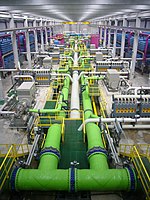
Photo from wikipedia
New protein sources in fish feed require the assessment of the carry-over potential of contaminants and anti-nutrients from feed ingredients into the fish, and the assessment of possible health risks… Click to show full abstract
New protein sources in fish feed require the assessment of the carry-over potential of contaminants and anti-nutrients from feed ingredients into the fish, and the assessment of possible health risks for consumers. Presently, plant materials including wheat and legumes make up the largest part of aquafeeds, so evaluation of the transfer capabilities of typical toxic metabolites from plant-infesting fungi and of vegetable phytoestrogens into fish products is of great importance. With the aim of facilitating surveillance of relevant mycotoxins and isoflavones, we have developed and validated a multi-analyte LC-HRMS/MS method that can be used to ensure compliance to set maximum levels in feed and fish. The method performance characteristics were determined, showing high specificity for all 25 targeted analytes, which included 19 mycotoxins and three isoflavones and their corresponding aglycons with sufficient to excellent sensitivities and uniform analytical linearity in different matrices. Depending on the availability of matching stable isotope-labelled derivates or similar-structure homologues, calibration curves were generated either by using internal standards or by matrix-matched external standards. Precision and recovery data were in the accepted range, although they varied between the different analytes. This new method was considered as fit-for-purpose and applied for the analysis of customised fish feed containing wheat gluten, soy, or pea protein concentrate as well as salmon and zebrafish fed on diets with these ingredients for a period of up to eight weeks. Only mycotoxin enniatin B, at a level near the limit of detection, and low levels of isoflavones were detected in the feed, demonstrating the effectiveness of maximum level recommendations and modern feed processing technologies in the Norwegian aquaculture industry. Consequently, carry-over into fish muscle was not observed, confirming that fillets from plant-fed salmon were safe for human consumption.
Journal Title: Toxins
Year Published: 2019
Link to full text (if available)
Share on Social Media: Sign Up to like & get
recommendations!